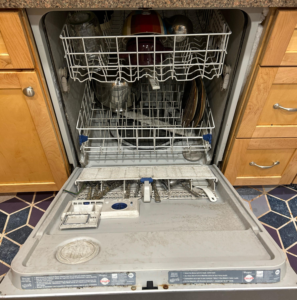Can You Safely Wash a Toilet Brush in the Dishwasher?
Cleaning our homes is essential, and the bathroom is one of the most critical areas for hygiene. The toilet brush plays a vital role in keeping this space clean. However, over time, this tool can collect germs, bacteria, and even fecal matter. So, is it safe to clean a toilet brush in the dishwasher? While some may find this method convenient, we will explore the potential risks and offer safer alternatives.

Understanding the Risks of Using a Dishwasher for a Toilet Brush
Using a dishwasher to sanitize a toilet brush may seem logical, but it can pose several problems. Here are the primary concerns:
1. Risk of Cross-Contamination
Dishwashers primarily clean dishes, utensils, and kitchen items that contact food. Putting a toilet brush in the same environment poses a significant cross-contamination risk. Harmful bacteria, like E. coli and Salmonella, can transfer from the brush to your plates, forks, and glasses. The thought of toilet germs on your eating utensils is both unsanitary and dangerous.
2. Ineffectiveness in Killing All Bacteria
Dishwashers may not reach the high temperatures needed to kill all the bacteria and pathogens on a toilet brush. While they excel at cleaning food residue from plates, they often struggle with the germs found on toilet brushes. Bacteria from fecal matter require stronger disinfectants and more targeted cleaning methods that dishwashers cannot provide.
3. Potential Damage to the Dishwasher and Brush
Toilet brushes are typically made of plastic, which may not withstand the high heat and intense water pressure inside a dishwasher. This can deform or damage the brush, rendering it less effective. Moreover, introducing non-kitchen items into your dishwasher may harm the appliance itself, causing clogs, scratches, or other mechanical problems.

Alternative Cleaning Methods for Toilet Brushes
Instead of using a dishwasher, consider safer and more effective ways to keep your toilet brush clean. Here are some alternative methods to ensure your bathroom stays germ-free without compromising your kitchen’s hygiene:
1. Bleach Solution: A Powerful Disinfectant
Soaking your toilet brush in a bleach solution is one of the best ways to disinfect it. Mix 1 part bleach with 6 parts water and let the brush soak for about an hour. Afterward, rinse it thoroughly with clean water and allow it to dry completely before returning it to its holder. This method kills bacteria and keeps the brush fresh for future use.
2. Hydrogen Peroxide: A Natural Disinfectant
For a less harsh option, use hydrogen peroxide to clean your toilet brush. This natural disinfectant works similarly to bleach. Simply soak the brush in hydrogen peroxide for a while, then rinse it off thoroughly with water. This method is effective and eco-friendly.
3. Vinegar and Baking Soda: A Chemical-Free Approach
If you prefer natural cleaning methods, vinegar and baking soda can work wonders. Soak the toilet brush in equal parts vinegar and water, then sprinkle baking soda into the mix. The fizzing reaction helps break down grime and bacteria. After soaking for about an hour, give the brush a good rinse and allow it to dry.

Best Practices for Toilet Brush Care
Keeping your toilet brush clean is essential for maintaining a hygienic bathroom. Here are some tips to ensure proper care:
1. Allow the Brush to Dry After Each Use
After using the toilet brush, avoid placing it back into its holder while it’s still wet. Moisture creates a breeding ground for bacteria. Instead, place the brush over the toilet or in a well-ventilated area to dry completely before storing it away.
2. Clean the Brush Regularly
Toilet brushes should be cleaned and disinfected regularly. Depending on usage, aim to clean it at least once a week using one of the methods mentioned above.
3. Replace the Brush Periodically
Even with regular cleaning, toilet brushes don’t last forever. If the bristles wear down or the brush develops an unpleasant odor, it’s time to replace it. Consider buying a new brush every six months to a year to ensure optimal cleanliness and functionality.
The Importance of a Clean Toilet Brush Holder
Don’t overlook the toilet brush holder, as bacteria can thrive here, too. Regularly clean and disinfect the holder using the same bleach, hydrogen peroxide, or vinegar solutions mentioned earlier. Keeping the holder clean ensures that the toilet brush remains hygienic and ready for future use.
Conclusion
Although cleaning a toilet brush in the dishwasher may seem convenient, the risks far outweigh the benefits. The potential for cross-contamination, ineffectiveness, and damage to your dishwasher make this practice unsafe. Instead, opt for alternative methods like bleach, hydrogen peroxide, or vinegar and baking soda to properly disinfect your toilet brush. Regular care and maintenance will help keep your bathroom sanitary while protecting your kitchen appliances. Prioritize health and hygiene by using safer, more effective methods to clean this essential bathroom tool.